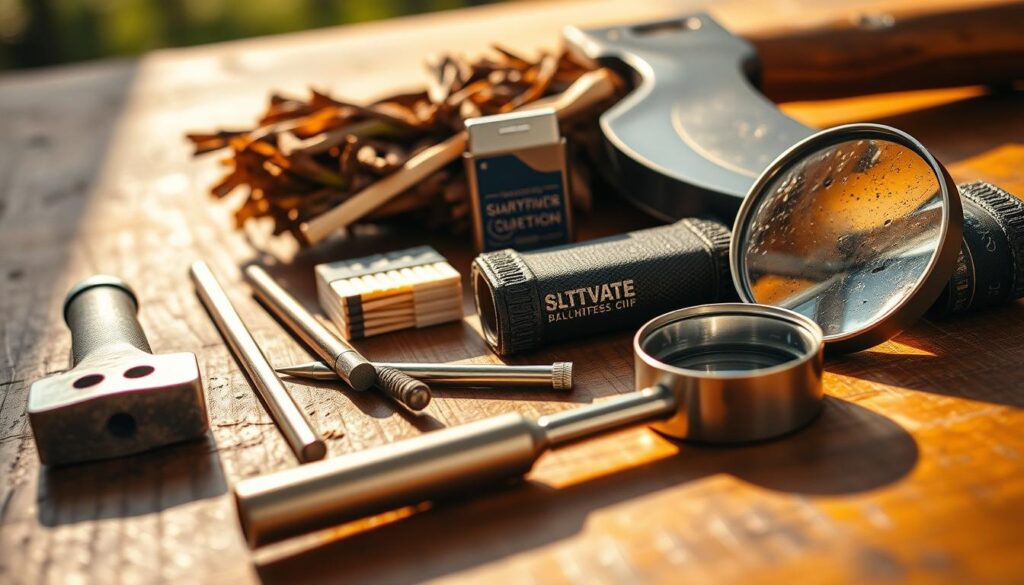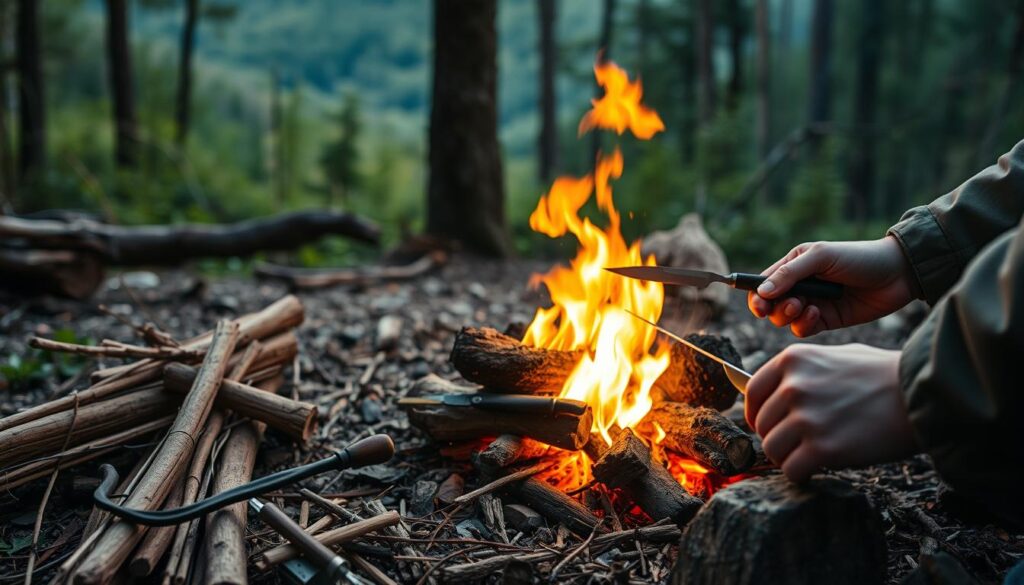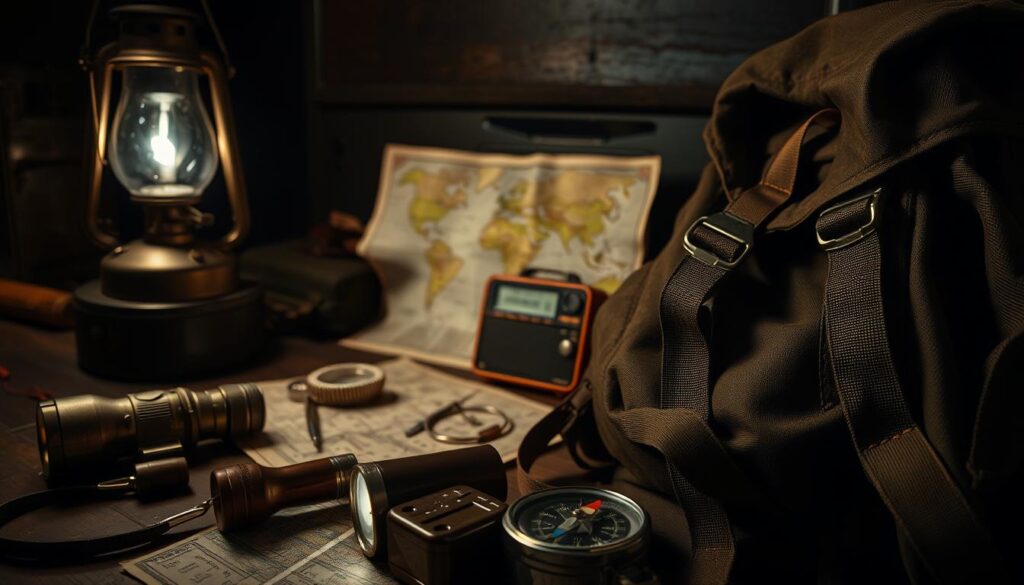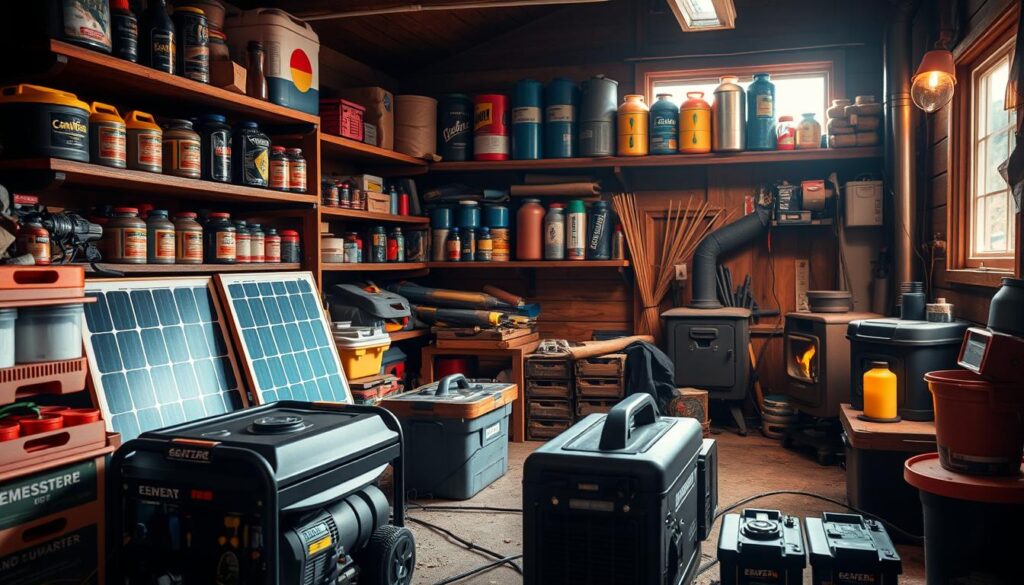Learning how to start a fire is a key survival skill. It has been perfected over thousands of years. Fire gives us warmth, light, and a way to cook food. It’s vital whether you love camping or are a prepper.
In this guide, I’ll show you the best fire starting techniques. We’ll cover everything from ancient methods to modern tools like tinder and electronic lighters. By the end, you’ll know how to start a fire anywhere. This will make you more self-sufficient and confident outdoors.
Key Takeaways
- Understanding the different types of fire starting methods
- Learning how to choose the right fire starting equipment for your needs
- Practicing fire starting techniques to become proficient
- Knowing how to start a fire in different environmental conditions
- Understanding safety precautions when starting a fire
Understanding the Basics of Fire Starting
Learning the basics of fire starting is key for outdoor fun. Fire gives us warmth, light, and a way to cook. To start a fire well, knowing its basic parts is important.
What Is Fire?
Fire is a chemical reaction that burns fuel fast, making heat, light, and other products. It’s a complex process, but knowing its basics is key for starting fires.
The Fire Triangle
The fire triangle has three main parts: fuel, heat, and oxygen. These are needed for fire to start and keep going. Take away any one, and the fire goes out.
Knowing the fire triangle is important. It helps us see what we need to start a fire. For example, good fuel is key because it’s what burns.
Importance of Fuel, Heat, and Oxygen
Fuel, heat, and oxygen are very important. Fuel is what burns, heat starts it, and oxygen keeps it going.
| Element | Role in Fire Starting | Example |
|---|---|---|
| Fuel | Provides material for combustion | Dry wood, dry leaves |
| Heat | Ignites the fuel | Matches, lighters, friction |
| Oxygen | Supports the chemical reaction | Air supply, ventilation |
Understanding fuel, heat, and oxygen helps us see how complex fire starting is. It also helps us do it better.
Essential Tools for Fire Starting
Having the right tools for starting a fire is key for a great outdoor adventure. The right gear makes starting a fire easier and safer.
Choosing the Right Tools
The tools you pick can greatly affect your success in starting a fire. Lighters and matches are simple but might not work well in bad weather. Ferrocerium rods (ferro rods), on the other hand, are tough and work even when wet.
Think about where you’ll be and the weather when picking your tools. For wet or windy places, ferro rods are a better choice.
Types of Fire Starters
There are many fire starters, each with its own benefits. Here are some popular ones:
- Lighters: Easy to use but might not work in extreme weather.
- Matches: Simple but hard to use in windy or wet conditions.
- Ferro Rods: Reliable and durable, making sparks to light tinder.
- Fire Pistons: Small and efficient, using pressure to light tinder.
| Fire Starter Type | Reliability | Ease of Use |
|---|---|---|
| Lighters | Moderate | Easy |
| Matches | Low | Moderate |
| Ferro Rods | High | Moderate |
| Fire Pistons | High | Easy |
Safety Gear for Fire Starting
Always put safety first when starting a fire. Fireproof gloves protect your hands from burns. Also, using a fire pit or fire ring keeps the fire in one place.
Having a fire extinguisher or a bucket of water nearby is smart. It helps put out the fire if it gets too big.

Natural Fire Starting Methods
Learning how to start a fire naturally is key for wilderness survival. These methods help you start a fire without modern tools. This is very useful in emergencies.
One easy way to start a fire is with dry leaves and bark. You can find these in many places. They can create enough friction to spark a fire.
Using Dry Leaves and Bark
To start a fire with dry leaves and bark, collect a lot of dry material. Look for dead branches, twigs, crunchy leaves, and brown pine needles. Make sure the material is dry and brittle to ignite easily.
The Bow Drill Technique
The bow drill technique is another good way to start a fire. It uses a bow, a drill, a fireboard, and a handhold to create friction and heat. This method takes practice but is very reliable.
Fire by Friction
Fire by friction includes the bow drill technique. It makes heat and sparks by rubbing sticks together. This method needs patience but works well in survival situations.
| Method | Materials Needed | Difficulty Level |
|---|---|---|
| Dry Leaves and Bark | Dry leaves, bark, twigs | Easy |
| Bow Drill Technique | Bow, drill, fireboard, handhold | Moderate to Hard |
| Fire by Friction | Two sticks | Moderate to Hard |
Chemical Fire Starting Methods
In some cases, chemical fire starters are the best choice. They use substances like lighter fluid and firestarter gel to start fires. These methods work well in wet or windy weather when other methods might not.
Overview of Chemical Fire Starters
Chemical fire starters help start fires quickly and efficiently. They come in liquids, gels, and solids. Lighter fluid is a common one, used for grills and campfires. Firestarter gel is also popular for its ease and effectiveness in various weather.

The Role of Lighter Fluid
Lighter fluid is key in chemical fire starting. It’s a volatile liquid that vaporizes easily, making it simple to ignite. But, it’s important to use it safely and follow the instructions to avoid accidents. Always use it in a well-ventilated area and away from flammable materials.
Using Firestarter Gel
Firestarter gel is another effective option. It’s less messy and more controlled than lighter fluid. To use it, apply it to your firewood or kindling and ignite it with a match or lighter. It burns longer than lighter fluid, providing a sustained fire.
| Fire Starter Type | Ease of Use | Safety Considerations |
|---|---|---|
| Lighter Fluid | Easy | Highly volatile, use in well-ventilated areas |
| Firestarter Gel | Very Easy | Less messy, but flammable |
Both lighter fluid and firestarter gel have their benefits. Choose the right one for your fire starting needs. Always follow safety guidelines to avoid risks.
Fire Starting with Everyday Items
You don’t need special tools to start a fire. Many everyday items can do the job. Some of the best methods use things you probably have or can find easily.
Using a Battery and Steel Wool
Starting a fire with a battery and steel wool is simple. Rub the battery’s terminals on steel wool to create a spark. This spark can light a fire. The steel wool gets hot and then ignites.
Finding Fuel in the Kitchen
Your kitchen has many items that can start a fire. Dryer lint is very flammable and works well as tinder. You can also use paper products, cardboard, or some food packaging to help start your fire. Learn more about fire starting techniques.
Cotton Balls and Petroleum Jelly
Cotton balls soaked in petroleum jelly are great fire starters. The petroleum jelly makes the cotton ball burn longer and hotter. This gives you a flame that can light bigger logs.
To make one, just cover a cotton ball with petroleum jelly. Once lit, it will burn for a while. This gives you time to add bigger logs to the fire.
These methods show you can practice fire starting at home. Even without being in the wilderness, you can try these techniques. It’s a good way to be ready for any situation.
Advanced Fire Starting Techniques
When basic fire starting methods aren’t enough, it’s time to explore more advanced techniques. These ensure a reliable flame. As someone who has ventured into the wilderness, I know how important it is to have strong fire starting skills.
The Fire Plough Method
The fire plough method is a primitive yet effective technique. It involves creating friction between two sticks to generate heat and eventually an ember. This method requires some practice to master, but it’s a valuable skill for any outdoor enthusiast.
To start, you’ll need a softwood base and a hardwood stick. The technique involves rubbing the hardwood stick quickly and firmly along the groove in the softwood base, creating friction and heat.
The key to success with the fire plough method is maintaining the right amount of pressure and speed. Too little, and you won’t generate enough heat; too much, and you risk breaking the stick.
Using a Fire Piston
A fire piston is a more sophisticated tool that uses compression to ignite a tinder material. It’s a compact and reliable method for starting fires, even in damp conditions. To use a fire piston, you simply place a small piece of tinder inside, compress the piston, and it ignites the tinder with a spark.
The advantage of a fire piston is its ability to work in conditions where matches or lighters might fail. It’s a valuable addition to any survival kit.
Flare and Emergency Fire Kits
Flare and emergency fire kits are designed for situations where a fire is needed quickly. This includes survival situations or for signaling. These kits usually contain a variety of fire starting tools, including flares, matches, and lighters, designed to be used in challenging conditions.
As noted by survival expert Ray Mears, “A good fire starter is one that is reliable, easy to use, and works in a variety of conditions.” Flare and emergency fire kits embody these qualities, making them an essential component of any outdoor or emergency preparedness plan.
“A good fire starter is one that is reliable, easy to use, and works in a variety of conditions.” – Ray Mears
Starting Fires in Different Conditions
Adapting fire starting techniques to different environments is key to success. Whether it’s wet, windy, or dark, the right strategies can make a big difference.
Wet Conditions Challenges
Starting a fire in wet conditions is tough because of the lack of dry materials. It’s important to find or create a dry spot to work on. Look for dry leaves, twigs, or branches under trees or in protected areas.
Choosing the right materials is critical. Dry tinder, like the dry centers of logs or dry pine needles, can help start your fire. Techniques like the bow drill method are also effective, as they generate heat through friction.
| Material | Characteristics | Use in Wet Conditions |
|---|---|---|
| Dry Leaves | Highly flammable, dry | Excellent tinder |
| Dry Pine Needles | Easy to ignite, dry | Good kindling |
| Dry Twigs | Good for sustaining fire | Use as kindling and fuel |
High Wind Fire Starting
High winds can quickly put out a fire, making it hard to start and keep one going. It’s important to shield your fire from the wind. You can use rocks, snow, or dig a fire pit to create a windbreak.
Windproof lighters or matches are also helpful. Starting with a strong flame and having plenty of fuel can help your fire stay lit in windy conditions.
Nighttime Fire Starting Strategies
Starting a fire at night is harder because of the lack of light. Having a reliable light source, like a headlamp or flashlight, is essential to see what you’re doing.
Use dry, flammable materials and have a backup fire starter, like waterproof matches or a ferrocerium rod. Preparing your materials ahead of time and having a clear plan can also help.
By understanding the challenges of different conditions and using the right strategies, you can start a fire in various environments.
Safety Precautions When Starting a Fire
Fire safety is key when starting a fire. This is true for camping, backyard barbecues, or fire pits. Being careful is essential to avoid accidents and have fun.
Fire Safety Rules to Follow
First, follow basic fire safety rules. Keep a fire extinguisher or water nearby. Make sure the fire is out before leaving it. Also, watch your surroundings to stop the fire from spreading.
- Keep a safe distance from flammable materials.
- Monitor wind conditions to prevent fire spread.
- Never leave a fire unattended.
As Rick Green, a fire safety expert, once said,
“Fire safety is not just about following rules; it’s about being aware of your environment and taking proactive steps to prevent fires from getting out of control.”
Creating a Fire Safety Plan
Creating a fire safety plan is important. Identify fire hazards, have a clear escape route, and pick a meeting spot in case of an emergency.
| Component | Description | Importance Level |
|---|---|---|
| Fire Extinguisher | A device used to put out fires | High |
| Escape Route | A planned path to safety in case of a fire | High |
| Meeting Spot | A designated area where people gather once they’ve escaped a fire | Medium |
Understanding Local Fire Regulations
Knowing local fire regulations is key. These rules can change a lot from place to place. They might limit fire sizes, types, and safety steps.
Some places have burn bans in dry seasons. Others need permits for certain fires. Knowing these rules helps avoid fines and keeps everyone safe.

By following safety rules, making a plan, and knowing local laws, we can lower fire risks. It’s all about being ready and responsible.
Building and Maintaining Your Fire
Starting a fire is just the first step. Building and maintaining it is key for a great camping trip. A good fire gives you warmth, light, and a way to cook.
How to Build a Fire Structure
Building a fire structure means making a fire lay for good airflow. Start with a teepee or log cabin. Use dry, fluffy kindling in the center. The teepee is great for beginners because it’s easy to make and lets air flow well.
To make a teepee, put dry leaves or small twigs in the middle. Then, put kindling sticks around it, leaving space for air. Light it with a match or lighter. Once it’s burning well, add more fuel, like bigger sticks.
Adding Fuel to Your Fire
Adding fuel is key to keeping your fire going. Use dry, seasoned wood to avoid smoke. Keep dry firewood nearby to add fuel as needed.
Start with small sticks and add bigger logs. This keeps the fire burning well. Make sure the fuel lets air flow to keep the fire efficient.
Maintaining Fire Safety
Fire safety is very important. Always have water or a fire extinguisher ready. Keep the fire away from things that can catch fire, like leaves or tents.
When you’re done, make sure to fully put out the fire. Use water to drown it, stir the ashes, and repeat until it’s out. This helps prevent forest fires and protects the environment.
Eco-Friendly Fire Starting Options
Exploring eco-friendly fire starting, I find natural materials are key. They help us reduce our environmental impact. When we’re outdoors, it’s important to think about our actions, including how we start fires.
Using Natural Materials for Starters
Dry leaves, twigs, and pine needles are great for starting fires without harming nature. They’re easy to find in most outdoor places. They help us create a fire that’s good for the planet.
I look for dry, fluffy stuff to start fires. This includes dry grass, small sticks, and other organic stuff found on the forest floor.
Avoiding Harmful Chemicals
Many fire starters have harmful chemicals that pollute our environment. Choosing natural materials helps us avoid these chemicals. It also reduces our impact on the planet.
It’s important to pick the right wood and materials for our fires. Stay away from treated or contaminated stuff.
Building a Leave-No-Trace Fire
A Leave-No-Trace fire is built to have little impact on nature. This means picking a safe spot, keeping the fire small, and making sure it’s out when we leave.
To make a Leave-No-Trace fire, I choose a spot away from trees and flammable things. I only use what I need and make sure the fire is fully out when I’m done.
Troubleshooting Common Fire Starting Issues
Starting a campfire can be tough, and it’s frustrating when it won’t light. I’ve faced this problem many times. Knowing the common issues can help you fix the problem.
Why Fires Won't Start
There are a few reasons a fire might not start. Inadequate fuel is a big one. If the fuel is too wet or not dry enough, it won’t light. Another issue is insufficient heat. If the spark or flame isn’t hot enough, it can’t light the fuel.
Oxygen supply is also key. If the area isn’t well-ventilated, or if the fuel blocks airflow, the fire won’t start.
Identifying Poor Fuel Choices
Choosing the right fuel is important for starting a fire. Poor fuel choices can make it hard to start or keep a fire going. Use dry, fluffy material like dry leaves, grass, or small twigs as kindling. Make sure you have enough tinder, like dry moss, pine needles, or small dry sticks.
Don’t use damp or rotten material because it won’t light well. Also, avoid using materials that are too dense or too big. They don’t burn well.
Dealing with Smoke and Soot Problems
Too much smoke and soot can be a problem when starting a fire. This often happens because of incomplete combustion. This can be due to not enough oxygen or fuel not burning right.
To reduce smoke and soot, make sure your fire has good airflow. Use the right fuel and try rearranging the fuel to help it burn better.
My Favorite Fire Starting Resources and References
I’ve gathered a list of top resources to boost your fire starting skills. These resources offer detailed info and practical training. They’re designed to make you skilled in different fire starting methods.
Recommended Books on Fire Starting
If you like learning from books, check out “The Wilderness Survival Guide” by Gregory J. Davenport. It covers the basics of fire starting. These books give you a deep understanding of fire starting and how to use it.
Useful Websites and Online Communities
REI Co-op and outdoor forums are great for learning about fire starting. They have lots of tutorials and tips from experts. It’s a treasure trove of knowledge.
Fire Starting Classes and Workshops
For hands-on learning, try fire starting classes and workshops. They’re run by outdoor centers and survival schools. Here, you can practice fire starting with the help of seasoned instructors.
FAQ
What are the basic elements required to start a fire?
To start a fire, you need three things: fuel, heat, and oxygen. These form the fire triangle.
What are some common natural fire starting methods?
Natural methods include using dry leaves and bark. The bow drill technique and fire by friction are also good. They work when you don’t have modern tools.
What are some everyday items that can be used to start a fire?
You can use a battery and steel wool. Cotton balls soaked in petroleum jelly also work. These items can spark a fire.
How can I start a fire in wet conditions?
In wet conditions, find dry materials. Use the bow drill to make a spark. This can ignite a fire.
What safety precautions should I take when starting a fire?
Always follow fire safety rules. Create a fire safety plan. Know local fire regulations to avoid accidents and wildfires.
How can I maintain a fire safely?
Build a fire structure and add fuel carefully. Keep the fire safe. Remember fire safety and local rules.
What are some eco-friendly fire starting options?
Use natural materials like dry leaves and twigs. Pine needles are also good. They start fires without harming the environment.
What are some common issues that can prevent a fire from starting?
Issues include bad fuel choices, not enough heat, and no oxygen. Troubleshoot and adjust your technique to start a fire.
Where can I learn more about fire starting techniques and safety?
Learn from books, websites, and online communities. Fire starting classes and workshops are also great resources.
What are some advanced fire starting techniques?
Advanced techniques include the fire plough method and using a fire piston. Flare and emergency fire kits are also effective in certain situations.
How can I start a fire in high winds?
Shield the fire and use windproof lighters. This protects the flame and helps start a fire in windy conditions.



